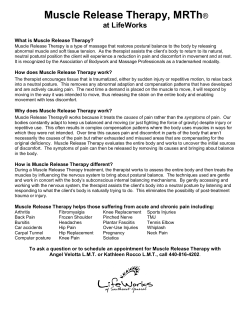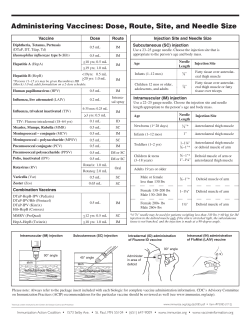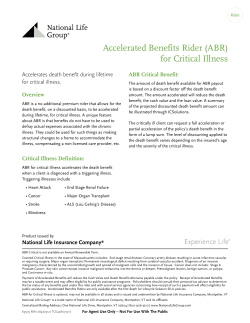
Specific Protein needs for select segment of population- Medical, Sports and Elderly By
Specific Protein needs for select segment of populationMedical, Sports and Elderly By Dr. Parmeet Kaur Senior Dietician AIIMS Protein needs in adult clinical conditions/hospitalized patients Starting point of estimating protein needs in a clinical setting is assessment of – Body weight With in normal BMI- 18.5 – 25Kg/m2 use actual weight Underweight- use actual weight Overweight/Obese- Use ABW ABW = actual body weight – Ideal body weight x .25 + Ideal body weight – Current NS – Current metabolic and disease states – Individualized goals Energy and Protein Requirements consensus document from Queensland Health dietitians,2011 Nelms, M.; Sucher, K.; Long, S. (2007). Nutrition Therapy and Pathophysiology. Thomson Higher Education, California: Thomson Brooks/Cole. Patient Category Cal/kg Protein g/kg 25-30 1.0 30-35 1.2 – 1.5 35-40 1.5 – 2.0 Not hypermetabolic Sedentary Adults, CVA, Gullian Barre Syndrome, Ulcerative Colitis/Crohns, AIDS, respiratory distress Moderately Hypermetabolic Post operative (~14 days). Repletion, infection, cancer cachexia, chemo/XRT, BMT, pancreatitis, peritonitis, burns ( upto 20 %) Hypermetabolic and Malabsorption Malabsorption, Mutitrauma, sepsis, head injury, burns ( > 20 %), liver disease Energy and Protein Requirements consensus document from Queensland Health dietitians,2011 Nelms, M.; Sucher, K.; Long, S. (2007). Nutrition Therapy and Pathophysiology. Thomson Higher Education, California: Thomson Brooks/Cole. Patient Category Cal/kg Anorexia Nervosa/ Refeeding risk & Critically ill (increase gradually, monitor relevant parameters) 25 Renal – use *IBW CRF: GFR>30; nephrotic (>3g urinary protein/day) CRF: GFR>30, >60yrs Haemo/IPD, CVVHD CAPD *IBW – Males- 50kg + 2.3kgfor each inch over 5 feet Females- 45.5kg + 2.3kg for each inch over 5 feet 25-30 30-35 30-35 35 Protein g/kg 0.75-1 0.75-1 1.2-1.4 > 1.2 Appropriate protein provision in Critical illness (ICUs) • Critical ill Patient- who are at high risk for actual or potential life-threatening health problems. • Currently, widely varying recommendations have been published with regard to the appropriate amount of protein or amino acids to be provided in critical illness • Hoffer & Bistrain, Am J Clin Nutr DOI:10.3945/AJCN.111.032078 Why feed the critically ill patient? Metabolic changes occur in response to starvation, trauma and sepsis How to feed the critically ill patient? Enteral Nutrition (EN) the delivery of nutrients in liquid form directly into the stomach, duodenum, or jejunum or Parenteral Nutrition (PN) nutrients are supplied intravenously, thus bypassing the patient's digestive tract entirely Starvation & Trauma Skeletal muscle Amino Acids Liver Glucose Protein breakdown Amino acids Glucose Synthesis Lactate from tissues Adipose tissue Glycerol Triglyceride Glycerol & FFA FFA Sepsis Skeletal muscle Protein breakdown Amino Acids Liver Glucose Glycogen Amino acids Glucose Synthesis Ketone Bodies Lactate from tissues FFA Adipose tissue Glycerol Triglyceride Glycerol & FFA Aims of Medline literature search Hoffer & Bistrain, Am J Clin Nutr DOI:10.3945/AJCN.111.032078 Medline literature search was done for clinical trials published in English between 1948 & 2012 of critically ill patients • To identify & analyze all prospective clinical trials of any kind that compared clinically relevant consequences of providing different levels of proteins or mixed amino acids to critically ill adults • To analyze all the available evidence pertinent to the safe upper limit of protein provision in critical illness Medline Search Key words • Critical Illness- Critical illness, critical care, burns, infections, inflammation, shock (including multiple organ failure, surgical shock, traumatic shock, systemic inflammatory response), wound & injuries and trauma • Level of protein – Nutritional support, dietary proteins, amino acids, nutritional requirement, nutritional physiologic phenonmenon Effect of varied protein intakes on outcomes in critical illness Author, Year, Country No. of Pt Interve Daily Outcome pts charact ntion Protein measure studied erstics &/or aa Singer et al , 2007 Israel 14 Critical illness, Mod ARF Ishibas hi et al 1998 NZ 23 Muller et al 1995 20 Germany PN Results Comments 75 & 150 g N balance All outcome ↑ 150 g Body weight not indicated Approx 2.1g/kg Critical PN & illness, EN sepsis, trauma 0.9, 1.2, 1.5g/k g FFM after ↓0.9, 10 days ↑ 1.2, ↑1.5 g/kg ↓ enrolment ↓ SP Critical illness, ns 0.5-2.0 N balance Optimum Complex Balance study at ↑ aa PN Sequent ial 12h Varying Infusion Effect of varied protein intakes on outcomes in critical illness Author, Year, Country No. of Pt pts charact studied erstics Interve ntion Tayman et al , 1985 USA 14 Critical illness, severe head injury 1.5 & EN 10days, 2.2 2 g/kg protein doses Pitkane 50 n et al et al 1991 Finland Critical illness, sepsis, trauma 5 PN Aa rgm Larsson 0 et al 1990 Critical illness, burn 5 PN Aa rgm Sweden Daily Outcome Protein measure &/or aa Results Comments ↑ NB With ↑ protein dose Non-blinded 0NB 1.5g/kg NB Least neg at ↑ aa ↓ enrolment ↓ Stats Power 0 - 1.88 N B g/kg NB↑ Non-blinded until 1.25, no imp at ↑ doses NB Effect of varied protein intakes on outcomes in critical illness • Despite their suboptimal quality, every study indicated improving nitrogen balance, protein turnover or better clinical outcomes as proteins or aa provision was increased. • The highest protein level studied was 2.5g/kg/d Upper limit of protein provision • Masters & Wood (2008) observed that adults with severe burns in US & Australia are routinely provided with 2-3 g protein/kg/d • ASPEN (2009) recommends that all hypocalorically fed, critically ill patient receive between 2 and 2.5 protein kg/IBW/d • Collins et al (1997) provided either 2.4 or 4.6g protein/kg/d to sev malnourished adults in a famine zone. ↑ protein ↓ outcomes Upper limit of protein provision • The available evidence indicates that protein provision in doses between 2.5 and 3.0g/kg normal BW/d are safe for use in clinical trials & careful clinical practice except in pts with refractory hypo-tension, overwhelming sepsis or serious liver disease Conclusion • It is strongly biologically plausible that sufficiently generous protein provision in crucial early days of critical illness could improve clinical outcomes • The limited amount of poor quality of the available evidence preclude conclusions or clinical rcdmns but suggest that 2.0-2.5g protein substrate/kg/BW/d is safe & optimum • Urgent need for well designed clinical trials Protein needs in Sports • There is probably no other nutrient that has captured the imagination of athletes more than protein. • Recent interest in the virtues of protein for both fat loss and muscle gain has ensured athletes, both endurance and strength focused, have taken a keener interest in their protein intake. • This heightened interest has also stimulated a flourishing protein supplement industry which has been very cleverly marketed. Total g of protein kg BW/d for atheltes Summary of recommendations from 6 review & book chapters Review Author Recommended Protein requirement (g) Batheja et al (2001) 1.2-2.2 Kreider (1999) 1.3-1.8 Lemon (1991) 1.2-1.7 Lemon( 2000) 1.6-1.8 Lemon (2000) 1.5-2.0 Philips (2005) 12-15% EI As per report of ILSI,NIN & SAI (2007) Nutrition & hydration guidelines for excellence in Sports Performance -1.0 to 1.5g/kg/BW for endurance athletes & body builders or 10-15% of total energy intake How Much Protein Are Athletes Eating? • Many athletes may already meet or exceed protein recommendations • Strength athletes in particular may believe that much larger protein intakes are necessary for increasing muscle mass – Intakes at 4 to 6 g/kg range are not uncommon – It is possible that this much protein intake could adversely affect the nutrient quality of the overall diet Tipton KD. Proc Nutr Soc. 2011;70(2):205-214. Protein Intake Recommendations for Athletes • American College of Sports Medicine (ACSM)/American Dietetic Association (ADA) – Endurance athletes, 1.2 to 1.4 g/kg per day • Based on nitrogen balance studies – Increased protein oxidation during endurance exercise – Strength athletes, 1.2 to 1.7 g/kg per day • Essential AAs are needed to support muscle growth, particularly during early phase of training when most significant gains in muscle occur and protein utilization is less efficient – Despite increased recommendations, ACSM does not state that protein supplementation has a positive impact on athletic performance ACSM and ADA. Med Sci Sports Exerc. 2009;41(3):709-731. Reported adverse effects of “High Protein” Diets • Hydration status – Eating protein beyond requirements can result in • Increased protein use for energy • Increased fat storage – The body must excrete the nitrogen from protein in urine (as urea) – Increased urinary output increases the likelihood of dehydration • Diets very high in protein may lack appropriate amounts of CHO, fiber, and some vitamins/minerals – Could impair exercise performance – Could increase long-term risk of diseases such as colon cancer • Possibly due to lack of fiber or increased intake of red meat • Excessively fatty protein sources could increase risk of CVD – Make sure protein sources chosen are mostly lean • For example, salmon is more desirable than a rib-eye steak Tipton KD. Proc Nutr Soc. 2011;70(2):205-214. Considerations for Protein Sources, Quality, and Turnover • Casein, whey, and egg are all high-quality proteins capable of supporting muscle growth • Whey protein supplementation appears to be particularly good at stimulating muscle protein synthesis – Leucine content highest (in addition to speed of digestion) • Casein may reduce muscle protein breakdown (slow digesting, high quality source ideal before bedtime) • Soy is also high quality according to the standard definition, but may be less ideal due to lower leucine content Combination of protein sources are ideal to get wide range of effects Hulmi JJ, et al. Nutr Metab (Lond). 2010;7:51. Nitrogen Balance and Athletes The RDA for protein (0.8 g/kg) is probably insufficient for maintaining nitrogen balance in either strength or endurance athletes • Endurance athletes may require ↑more protein than strength athletes to maintain nitrogen balance – Higher energy requirements dictate greater protein needs • Nitrogen balance, g/kg/day – Contracting skeletal muscles oxidize BCAAs for energy production – Adequate caloric intake to match physical demands is key in order to spare AAs for muscle protein synthesis Activity type Abbreviations: RDA, recommended dietary allowance; BCAA, branched-chain amino acids. Tarnopolsky MA, et al. J Appl Physiol. 1988;64(1):187-193. Protein needs in experienced vs novice Athletes • Experienced weight lifters require less protein intake per kg of lean body mass than that of novices • Less potential expansion of muscle mass to be added in experienced weight lifters – In the first month of training, 1.4 g protein/kg versus 2.4 g protein/kg for novices • Calculated 1.43 g/kg per day for nitrogen balance – Nitrogen balance no longer had significant relationship with protein intake above 2.0 g protein/kg – Increased AA oxidation generally seen above 2.0 g/kg • Generally indicates no further metabolic benefit, at which point additional protein is used purely as a substrate for energy production/storage – No apparent effect of >2.0 g protein/kg on strength Tarnopolsky MA, et al. J Appl Physiol. 1988;64(1):187-193. Lemon PW, et al. J Appl Physiol. 1992;73(2):767-775. Timing of Ingestion & Macronutrient Content of Meals • There is increasing agreement that immediate post-exercise ingestion of protein and/or carbohydrate has beneficial effects on – Muscle glycogen replenishment (particularly carbohydrate, protein may provide additional benefit) – Muscle protein synthesis (particularly protein, carbohydrate may have permissive effect due to insulin release) • A combination of both protein and carbohydrate seems to work better than either carbohydrate or protein alone – Proportions of carbohydrate/protein vary based on individual needs • Endurance athletes prioritize carbohydrate intake for glycogen replenishment • Bodybuilders prioritize protein intake for muscle growth Zawadzki KM, et al. J Appl Physiol. 1992;72(5):1854-1859. Ivy JL, et al. J Appl Physiol. 2002;93(4):1337-1344. Putting a Meal Plan Together • Example: 70-kg athlete requiring 4,000 kcal/day exercising 120 min/day, 4 to 6 times/week • Macronutrient Target Recommendations – Grams/kg body weight/day • Carbohydrate 7-10 g/kg (490-700 g/day) • Protein 1.5-2.0 g/kg (105-140 g/day) • Fat Typically use percentage of energy – Percentage of energy • Carbohydrate 55-65% of energy (550-650 g/day) • Protein 10-15% of energy (100-150 g/day) • Fat 20-30% of energy (88-133 g/day) • Target recommendations for this athlete • Carbohydrate • Protein • Fat 600 g/day (60% of energy) 130 g/day (13% of energy) 120 g/day (27% of energy) Protein Content of Various Foods 1 egg, 2 egg whites, or ¼ cup egg substitute 1 cup of milk ¼ cup cottage cheese 1 cup of yogurt 1 oz. of chicken, fish, pork, or beefa 1 oz. of cheese (except cream cheese) 1 slice of bread or ½ bagel 1 cup of cereal 2 Tablespoons peanut butter 1/2 to 2/3 cup of dried beans or lentils 1 cup miso 4 oz. raw, firm tofu ½ cup peas or corn ½ cup of non-starchy vegetables 8 oz. soy milk Protein drinks and powders/serving a3-ounce Protein Content, g 6-7 8-10 7 8 7 7 3 3-6 7 8 8 9 3 2 5-6 10-45 portion (21 g protein) is the size of the deck of cards. Pennington JAT, et al. Bowes and Church’s Food Values of Portions Commonly Used. 17th ed. Philadelphia, PA: Lipppincott Williams & Wilkins; 1998. Summary • Adequate protein intake is critical for athletic performance and good health • For most athletes, protein intakes of 1.5 to 1.8 g/kg/day (0.68-0.81 g/lb/day) will meet protein requirements • High quality protein sources (eg, dairy products, meats, fish, chicken, soy, eggs) should be included in the diet • Eating a combination of carbohydrate and protein soon after exercise can help with muscle recovery and building Summary • Research is emerging on potential benefits of certain amino acids or amino acid metabolites for athletes – First rule is to get appropriate amount of high quality protein from diet • There are several disadvantages of excessive protein intake (ie, well above 2 g/kg/day) – In general, no additional benefit for strength or muscle building – Increased water loss from the body due to disposal of excess nitrogen in urine, which may lead to dehydration – May replace carbohydrates and other vital nutrients for athletic performance and good health Quantity of Protein in Older Adults • Currently there is no consensus on whether dietary protein needs change with advancing age. • The current recommendation for protein intake for all men and women aged 18 y and older is 1.0 g·kg−1·d−1, established by the ICMR (2010) based on NB studies on healthy adult Indian subjects & NB studies do not provide enough evidence to make a recommendation. • Nitrogen balance studies may be appropriate for establishing the nitrogen or amino acid requirements to prevent deficiency, the question of whether they are an appropriate means of establishing optimal intakes for maintenance of muscle mass, strength, and metabolic function remains. Body composition changes & protein status • The most noticeable feature of aging is body composition changes with the loss of protein tissue being most ( Chernoff, 2004). • The reduction of protein compartments, including red blood cells, white blood cells, platelets, stem cells, antigens, antibodies, hormones, enzymes and others, contributes to impaired wound and fracture healing, loss of skin elasticity, an inability to fight infection, muscle weakness potentially leading to falls, decreases in functional capacity, and an inability to maintain tissue integrity ( Castaneda et al, 1995, Fielding, 1995). Wound healing & recovery from illness • It will take longer for older patients to return to pre-injury status, they can heal wounds and repair fractures although it will still require more time for older patients to return to baseline status than it will for younger adults; if there is a deficit of protein and energy, it will take even longer. • Older adult patients may also develop pressure ulcers rapidly due to a lack of adequate subcutaneous fat pads, skin fragility, and poor muscle tissue integrity. Protein Requirements in Elderly women & BMR • Adult protein requirement is a fixed function of weight and independent of sex or age, but for elders, especially women, more protein-dense diets are required than do younger adults or children to meet both protein and energy requirements . • This is because basal metabolic rate (BMR), and hence energy requirement, decreases with age and is lower in women than in men at any level of physical activity. Thus, the protein requirement expressed in relation to the energy requirement (P:Erequirement ratio) increases with age, especially in women, and elderly women are most vulnerable to any diet marginal in protein. Millward, 2008 Whether common protein-rich foods can stimulate muscle protein anabolism in older people ? • Recent data suggest that a moderate 113 g (4 oz) serving of an intact protein (ie, lean beef) contains sufficient amino acids (30 g total; 10 g essential amino acids) to increase mixed muscle protein synthesis by ≈50% in both young and elderly men and women (Symone et al, 2007) • Promoting muscle anabolism with plant- and animal-based protein-containing foods is advantageous as they are readily accessible, relatively inexpensive, and palatable, whereas supplements such as essential amino acids frequently are not. • Although targeted amino acid supplementation may indeed be beneficial in cases involving accelerated protein catabolism (eg, advanced sarcopenia, cachexia, and trauma) (Dillon et al, 2007) Conclusion • There are compelling data to support the ability of dietary protein to acutely stimulate muscle protein synthesis in aging individuals. • There is general agreement that moderately increasing daily protein intake beyond RDA may enhance muscle protein anabolism and provide a means of reducing the progressive loss of muscle mass with age. • However, current research has not identified a synergistic or additive effect of protein supplementation and resistance exercise on muscle protein anabolism in aging populations. • Assessment of renal function is recommended for older individuals before they adopt a higher-protein diet. • A reasonable strategy to maintain health in older adults is to assure adequate dietary protein intake with high biological value protein that is inexpensive, easy to prepare, and well-tolerated. THANK YOU
© Copyright 2025





















